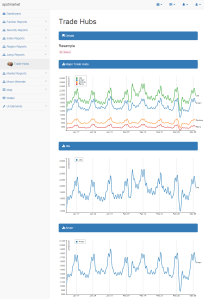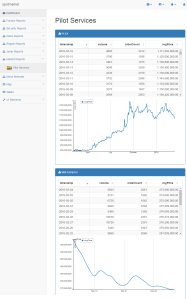spotmarket – 0.4
Posted: 2016-03-18 Filed under: python, spotmarket | Tags: amarr, dodixie, fountain, jita, PLEX, rens Leave a commentOverview
Whew, this was a big step in the right direction. I added a lot of sanity (keep everything in UTC), usability, and cleanup to the existing design. We’ve got moongoo, the beginnings of indexes, and CREST killmail data now flowing in to the growing dataset. The backend was improved by migrating to PostgreSQL 9.5.1 and I also cleaned up the install directions to try to make it easier.
[bug] Change timestamp for zkillboard and markethistory consumer to use UTC for mental sanity
[enhancement] Add 404 error page
[enhancement] Change to postgres 9.5.1 to support jsonb
[enhancement] Parameterize graph functions
[enhancement] Change date format in graphs to ISO for mental sanity
[enhancement] Standardize table formatting
[enhancement] Supervisor to make Flask web service persistent
[enhancement] Add jsonb index on data.killmails for typeID and solarSystemID
[enhancement] Add paging to zKillboard consumer
[enhancement] Add check to resume from last recorded page for zKillboard consumer
[enhancement] Add basic exception handling to zKillboard consumer
[new] Creation of ship index report
CREST Verified Moon Minerals
It is no secret that I have an affinity for finding accurate moon data. In a previous post, I’ve gone so far as to chart the regional density of each moon mineral, showing that there were built in skews as to where each type was placed for each class (R8, R16, etc).
In the Rubicon expansion, CCP introduced siphon units, which can be anchored near a POS to slowly leech items from within the shields. When an extractor is destroyed the killmail will show what moon mineral was in it. This, combined with the x,y,z location data that started to be exposed after the Parallax expansion, can be used to locate the nearest celestial object to give us a verified report of what moon mineral is contained in the object.
I gathered some examples for anyalisis, and over a long flight, I started to put some code together to use killmail x,y,z coordinates to parse CREST killmails. After implementation and testing, it has proven to be accurate so I’ve included the feature in this release. There is a manual step to get the moon mineral data into a table where it is used in the web frontend; I wanted to keep them separate to isolate the two datasets.
PostgreSQL Upgrade to 9.5.1
Rather than writing a parser for CREST killmails, I decided to store the JSON itself for simplicity. Developing on 9.3 with the json datatype proved to be a path that I did not want to go down. 9.3 is not the prefered version and lacked support for a fancy datatype inherit to 9.4+ and above. The following blog post also convinced me to migrate.
The proof is in the numbers so here’s a side-by-side comparison of the same query on the same dataset with only the datatype being different. The two virtual machines also had access to the same amount of CPU and RAM to control the results.
This query was proof enough that I made the right choice. Later that night while checking my logging table, I also noticed an improvement in insert speed.
9.3 (json) [kills] insert 2982 @ 93.81 rec/sec 9.5.1 (jsonb) [kills] insert 2850 @ 124.44 rec/sec
Not bad for about 45 minutes of testing and correcting install instructions.
0.5 Release
What’s up for the next release? Check out the TODO.md for a full list of items slated for each release. The main focus is going to be putting more control in the web front end, letting you enable/disable import items, add item to the market/zKillboard watch list, etc.





